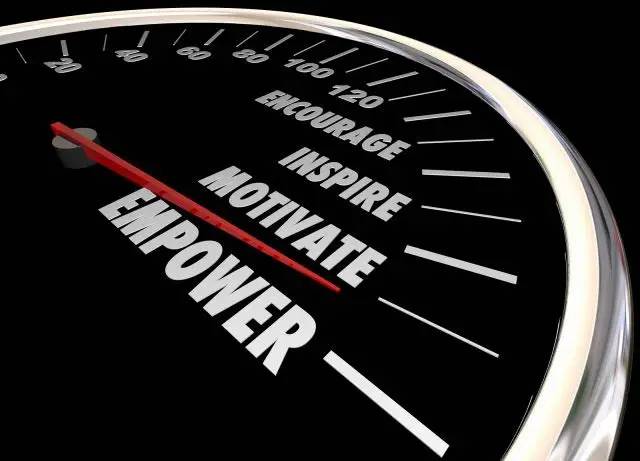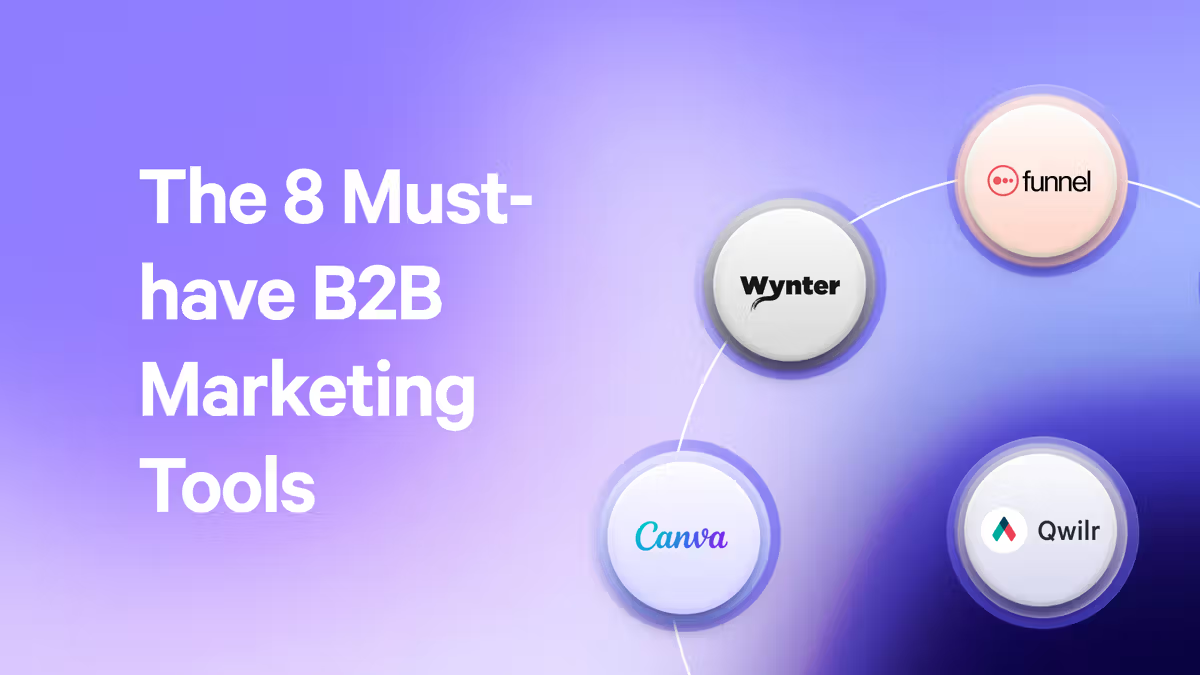We write a lot about sales and sales enablement—everything from tools and techniques to methodologies to enable modern sales organizations. So, for our marketers in the audience, this one’s for you!
We looked at many of the popular and emerging B2B marketing tools available today and curated a list of the best of the best for every sized business. We narrowed down the list to our favorite tools for each marketing function and took into account criteria such as feature stack, usability, price, use cases and customer reviews.
Based on our research, our top picks for a robust marketing tech stack include:
- Qwilr: Best proposal & enablement tool
- HubSpot: Best B2B marketing automation solution
- Funnel: Best B2B marketing analytics software
- Wynter: Best messaging testing tool
- Hotjar: Best website heatmap & analytics tool
- Ahrefs: Best SEO keyword research tool
- Uniqode: Best phygital marketing tool
- Canva: Best design tool for marketing teams
- Primer: Best B2B marketing audience creation tool
- Mutiny: Best website personalization platform
- Clearscope: Best SEO content optimization tool
- Livestorm: Best webinar management tool
- Klaviyo: Best B2B email marketing software
- Design.com: Best brand-building tool
Defining the B2B marketing tech stack
For the purposes of this article, let’s agree to define the marketing technology stack as the full suite of tools that help a marketing team conduct marketing initiatives and understand their impact.
This might include tools for sending marketing messages (email, landing pages, automation tools, animation software, video tools, and other content), automating marketing activity, and understanding the impact of the activity (analytics tools).
When thinking about your marketing tech stack and reading this article, think about your processes, your goals, and your needs. We’ll recommend some specific solutions that we think are great, but they might not all be right for your team’s needs and budget.
And here’s the thing: a tool is not a strategy. Sure, you can compare different software packages by their features, but that’s like marrying someone based on their dating profile. The real value marketing software offers is in the strategy and approach it enables — and how it impacts customer experience (the desired end result).
Think strategy first, technology second.
14 must-have B2B marketing software
These tools stand out from their competition by offering more robust features and integrations that can help make your marketing efforts go further. (Work smarter, not harder — right?)
1. Qwilr: Best proposal & enablement tool
G2 review: 4.5/5 (726 reviews)

If you’re still sending out sales and marketing PDFs and toiling with clunky, manual proposal software, you need Qwilr to dramatically upgrade your proposal game. While we’re known for being the best proposal software tool around, we don’t just help sales teams; we also address many of the marketing team’s needs.
From our intuitive and user-friendly interface to our ability to create high-quality, customizable, branded proposal templates, we can help marketing teams reach out to their target audience, too.
Once a piece of sales collateral is out in the hands of potential b2b buyers, our analytics capabilities help marketers understand what prospects are reviewing and how much time they’re spending engaging with each section of the marketing proposal. This information can help with content creation by showing marketers where they should focus their time and resources.
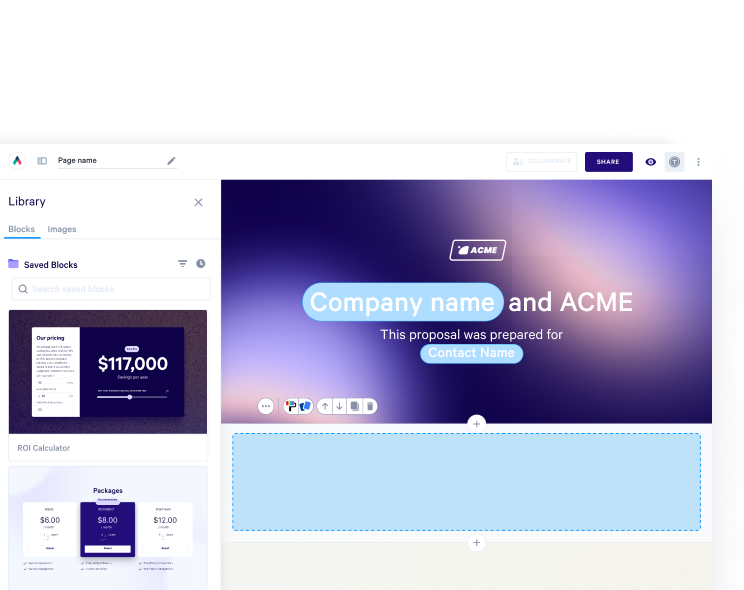
When you invest in Qwilr, consider using it as an internal enablement resource, too. Create beautiful and interactive playbooks, battle cards, and one-sheets your sales and marketing teams can use when they’re on sales calls with prospects or writing messaging for the newest marketing campaigns. Having all the key details at their fingertips will save hours of searching.
You can also learn how to write winning sales proposals and even try our AI proposal generator for free to create your own professional looking proposal in minutes.
Top features
- Interactive Marketing Collateral: Create interactive proposals and marketing documents that engage prospects with embedded videos, images, and links.
- Brand Consistency: Easily design marketing materials that align with your company’s branding, maintaining professionalism across all collateral.
- Analytics and Insights: Track how prospects engage with your content, including time spent on pages and interactions, to inform follow-up strategies.
- Seamless Collaboration: Share and collaborate on marketing assets with internal teams and clients, improving workflow and client approval processes.
- Customizable Templates: Leverage pre-built, customizable templates to create polished marketing documents quickly, saving time on content creation.
- Smart Integrations: Connect Qwilr with platforms like HubSpot, Salesforce, and Slack, allowing marketing and sales teams to automatically update records and streamline content delivery.
- Real-Time Alerts and Notifications: Receive instant alerts when prospects view, interact with, or sign a document, enabling timely follow-ups and improving sales velocity.
- Business: $35 USD per user / month
- Enterprise: $59 USD per user / month
2. HubSpot: Best B2B marketing automation software
G2 review: 4.4/5 (11,170 reviews)

When it comes to marketing automation software, HubSpot is likely the most well-known and most popular marketing automation platform on the market. Here at Qwilr, Hubspot is a key part of our daily marketing functions and is essential for our reporting, customer data, campaigns and so much more.
Our Revops Specialist, Dusty Martin reiterates:
So much information flows through our Hubspot and so many different people on our Go-To-Market team reference that information every day. Having it all run smoothly is absolutely critical to our success. Hubspot is the foundation that our GTM team sits on
With a broad range of tools and functionality, everyone from smaller businesses to larger enterprise teams can benefit from its marketing automation prowess. Hubspot has helped us reduce a ton of time spent on repetitive actions like lead scoring and sending out follow-ups.
Top features
- All-in-One Marketing Hub: Centralize all marketing efforts—email campaigns, social media, content, and more—in one platform to manage, automate, and optimize marketing initiatives.
- Marketing Automation: Automate email sequences, lead nurturing workflows, and content delivery to engage prospects without manual intervention.
- Content Management System (CMS): Create, optimize, and publish landing pages, blogs, and other marketing content, all while tracking performance.
- CRM Integration: Sync with the HubSpot CRM for seamless lead tracking and personalized marketing based on real-time customer data.
- Lead Scoring and Nurturing: Score leads based on engagement and behavior to prioritize the most valuable prospects, and set up nurturing workflows.
Pricing
- Marketing hub starter: $15 USD per seat / month
- Marketing hub professional: $800 USD / month
- Marketing hub enterprise: $3,600 USD / month
3. Funnel: Best B2B marketing analytics software
G2 review: 4.5/5 (153 reviews)
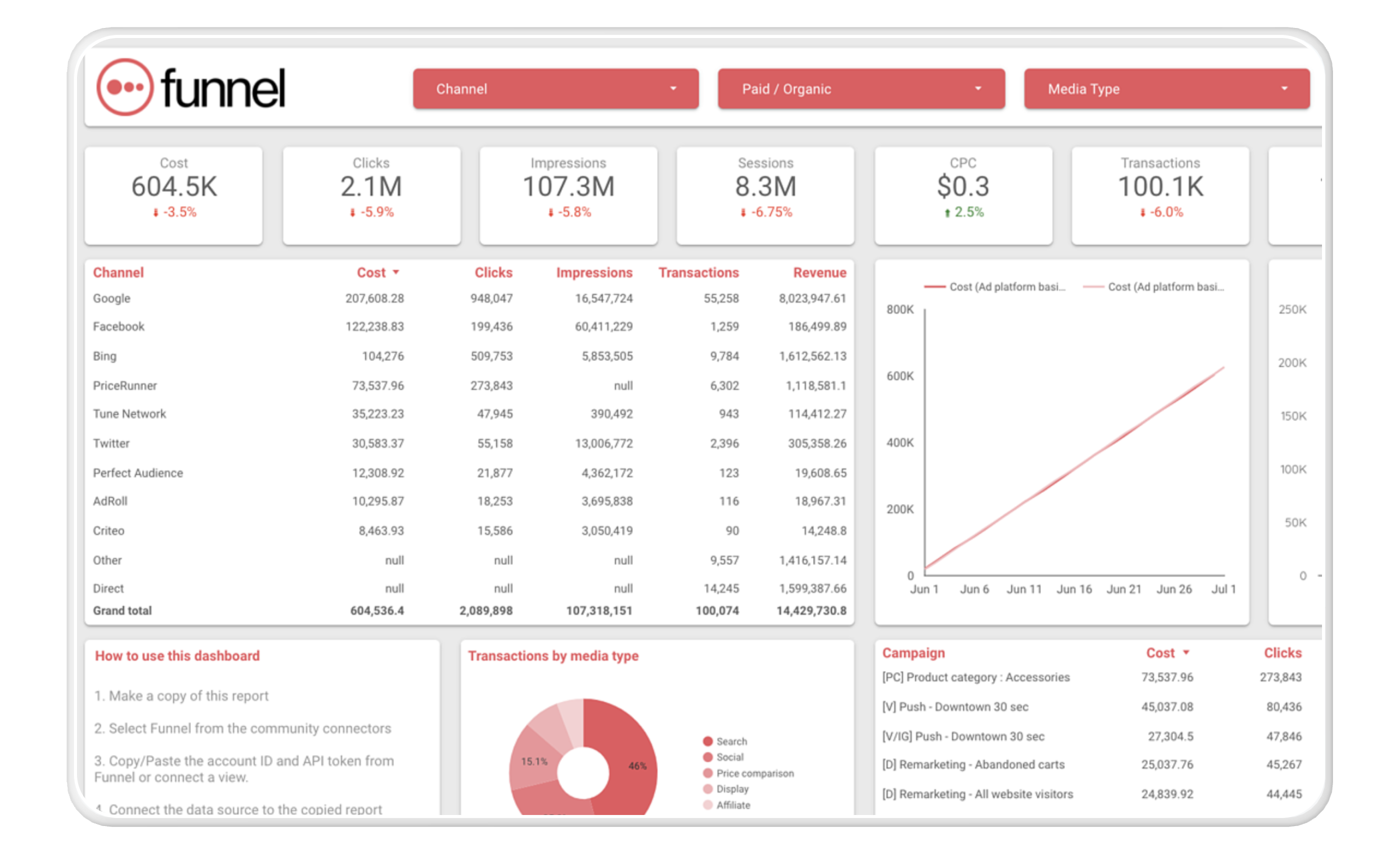
Funnel bills itself as your mission control for your B2B marketing data, and for good reason. It allows marketers to connect data from any source and store, organize, and share it. They say “Funnel empowers marketers to make data-driven decisions and create value for their business. Own your marketing data and use it independently from other teams.”
The Funnel team claims their tool can give marketers back 125 hours by automating reports each week—that’s a lot of time that could be put to better use, building and optimizing campaigns or strategizing with the sales team.
Top features
- Data Aggregation from Multiple Sources: Funnel automatically pulls data from over 500 marketing platforms (like Google Ads, LinkedIn, Facebook, and more), allowing you to consolidate and centralize your marketing data in one place.
- Customizable Data Visualization: Create tailored dashboards and reports that visualize your B2B marketing data in a way that’s easy to understand and actionable for your team.
- Automated Data Transformation: Funnel cleans, organizes, and transforms raw data into structured formats, enabling you to easily analyze and work with it without manual processing.
- Integration with BI and Analytics Tools: Seamlessly integrate with popular business intelligence (BI) tools like Google Data Studio, Tableau, and Power BI, allowing for advanced reporting and analysis of your marketing performance.
- Real-Time Data Updates: Keep your data up-to-date with automatic syncing, ensuring that your marketing reports always reflect the latest performance metrics, helping you make timely decisions.
Pricing
Funnel pricing works on ‘flexpoints’ which measure your usage on the platform. This means you only pay for the connectors and destinations that you use.
- Starter: $1.20 USD per flexpoint / month
- Business: $1.50 USD per flexpoint / month
- Enterprise: $2.00 USD per flexpoint / month
3. Wynter: Best messaging testing tool
G2 review: 4.8/5 (127 reviews)
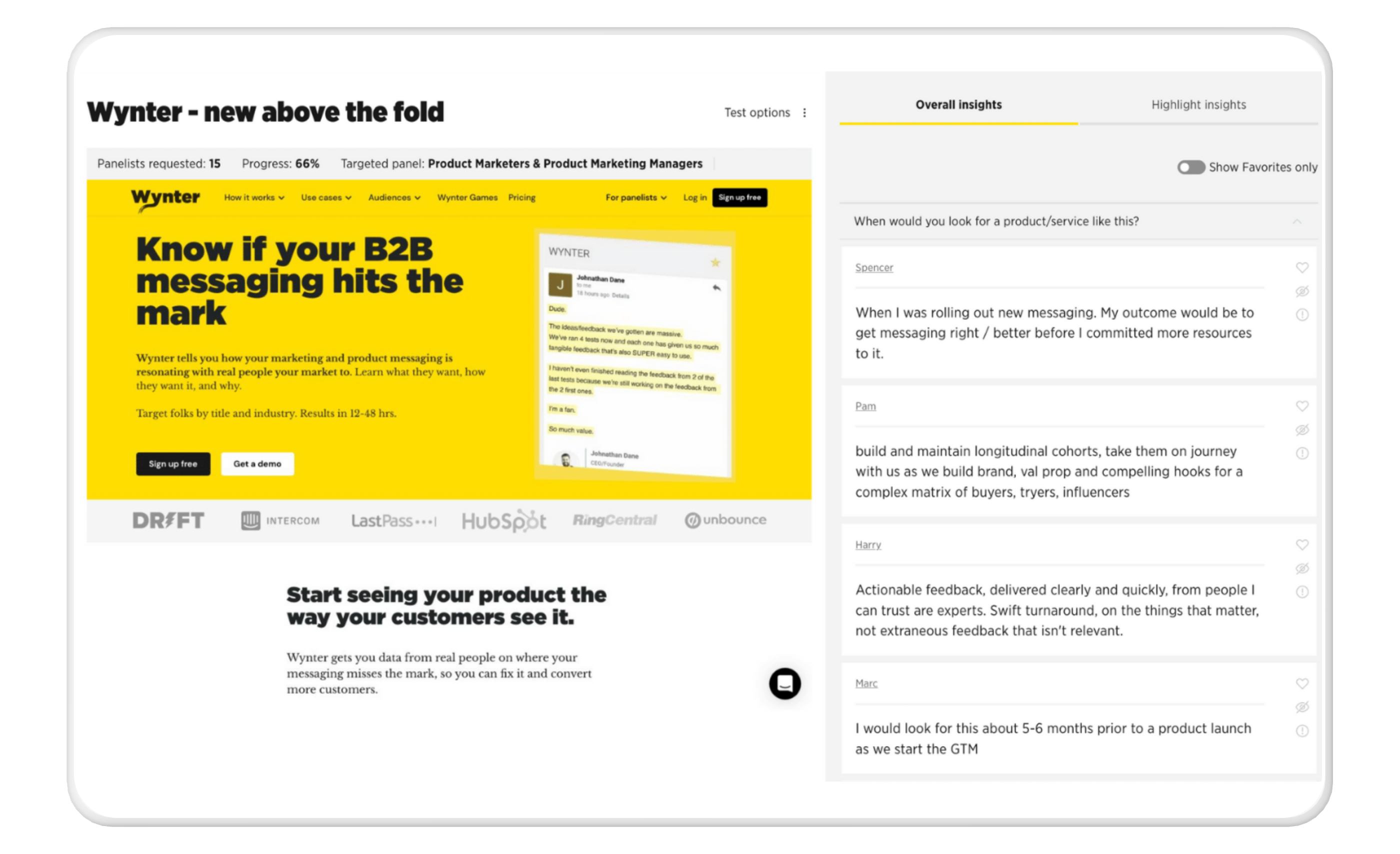
Not just for testing messaging, Wynter can help find or confirm product market fit. Wynter gives marketers access to their proprietary network of over 50,000 B2B professionals. Marketers can find out how target customers see their product and messaging, understand prospects’ biggest pain points, and how they buy. It can also help teach marketers exactly what buyers need to hear in order to convert straight from the horse’s mouth!
All of this is available on demand any time you need it. Whether you’re working to optimize your go-to-market strategy or want to test key messaging for landing pages, or email marketing initiatives, including specific email campaigns, Wynter can help marketers get real-time feedback from real potential customers.
Top features
- B2B Message Testing: Test B2B messaging directly with your target audience to understand how well your marketing resonates with them.
- Audience Segmentation: Run message testing on specific B2B audiences, such as decision-makers or certain industries, ensuring feedback is relevant.
- Real-Time Insights: Get quick feedback on your marketing messages, allowing you to refine them rapidly for better alignment with your target market.
- Competitor Messaging Comparison: Compare how your messaging stacks up against competitors, giving you insights into market positioning.
- Heatmaps and Reports: Visualize which parts of your marketing copy resonate most with your audience through detailed heatmaps and reports.
Pricing
- Pay as you go: Pay for what you use
- Lite: $6,000 USD / year
- Pro: $19,000 USD / year
- Elite: $29,000 USD / year
5. Hotjar: Best website heatmap & analytics tool
G2 review: 4.3/5 (304 reviews)

If you want to know more about what your website visitors are doing once they get to your site, consider installing Hotjar and getting some highly detailed data from heat mapping. This allows you to understand the customer journey that’s happening within your site.
Where are people coming into the site? What are they clicking on once they get there? Are there pages with significantly higher conversion rates? If you see this information, you can scale up what is working and spend less time and effort on what’s not!
We’ve spent a ton of time on Hotjar getting to know more about how our users behave and getting priceless insights to fuel important campaign and website decisions.
Top features
- Behavioral Analytics: Track user interactions with your website using heatmaps, scroll maps, and click tracking to understand how prospects engage with your content.
- Feedback Tools: Collect qualitative feedback from your B2B website visitors through surveys and on-page feedback tools, helping you refine messaging and UX.
- Conversion Funnel Analysis: Identify where prospects drop off during key conversion points, providing insights into optimizing your marketing funnel.
- Session Recordings: Watch recordings of actual user sessions to see how B2B buyers navigate your site and identify any pain points in their experience.
- User Segmentation: Segment user data based on behavior, company size, or other B2B-specific criteria to better target marketing efforts.
Pricing
- Basic: Free forever
- Plus: $32 USD / month
- Business: $80 USD / month
- Scale: $171 USD / month
6. Ahrefs: Best SEO keyword research tool
G2 review: 4.5/5 (537 reviews)

When it comes to scaling your organic channels, you need to understand the importance of search engine optimization. Having a tool like Ahrefs to not only support your keyword research, but all other SEO elements, is very important. While there are other good keyword research tools, such as SemRush, at Qwilr we’re huge proponents of Ahrefs. We love the user-friendly interface and range of features to support our SEO strategy beyond keyword research.
Our SEO Manager, Leah Alves-Hill tells us exactly what she loves about the tool:
I’ve been using Ahrefs for years and it’s a fantastic all-in-one tool. You can run almost all of your SEO operations and research with Ahrefs, and I’m always pleasantly surprised by the new features and updates—it just keeps getting better. In my experience it’s the best SEO tool out there
Ahrefs site explorer gives an in depth overview on site performance— including traffic, domain rating, organic keywords, backlink profile and more! With the competitor and gap analysis features you can quickly identify which keywords your competitors are targeting that you’re missing out on.
Top features
- SEO Keyword Explorer: Identify high-value B2B keywords to optimize your website and content for better search visibility within your target market.
- Competitor Analysis: Analyze competitors' backlinks, content strategies, and keyword rankings to stay ahead in the B2B space.
- Content Gap Analysis: Discover gaps in your content that competitors are filling, allowing you to create new content that attracts your target audience.
- Backlink Monitoring: Track your backlink profile and identify new opportunities to build high-quality links that improve your B2B site's domain authority.
- Site Audit Tool: Audit your website to uncover technical SEO issues that could be hindering search performance and user experience for B2B buyers.
Pricing
- Lite: $108 USD / month
- Standard: $208 USD / month
- Advanced: $374 USD / month
- Enterprise: $14,9990 / year
7. Uniqode (formerly Beaconstac): Best phygital marketing tool
G2 review: 4.9/5 (417 reviews)

Uniqode emerges as a premier phygital (physical plus digital) marketing tool, blending digital experiences with physical ones through its sophisticated and secure QR Code generator. Renowned for its exceptional rating of 4.94/5 on G2 and endorsements from heavyweight corporations like Pepsi, Amazon, and Marriott, Uniqode specializes in creating dynamic QR Codes.
This marketing tool enables businesses to track engagement, retarget audiences in real-time, and capture leads instantly by linking scannable QR Codes directly to email lists or CRMs. With its ability to integrate seamlessly with over 4000 applications, including powerhouse platforms like Salesforce and Zapier, Uniqode stands as a comprehensive solution for enriching your marketing campaigns.
Top features
- QR Code Generation and Customization: Create and customize dynamic QR codes for B2B campaigns, allowing marketers to track, update, and optimize content even after the QR code is deployed.
- Advanced Analytics: Track the performance of your QR code campaigns, including scan locations, device types, and user demographics, to optimize B2B marketing efforts.
- Integration with CRM and Marketing Tools: Seamlessly connect QR code data with tools like HubSpot, Salesforce, and Google Analytics to enhance lead tracking and campaign performance analysis.
- Security and Compliance Features: Ensure data privacy and security with GDPR-compliant QR codes, making Uniqode a reliable tool for B2B companies handling sensitive customer information.
- Multi-Channel Marketing Support: Use QR codes across various touchpoints, such as physical brochures, events, or digital ads, to bridge the gap between offline and online B2B marketing strategies.
Pricing
- Lite: $15 USD / month
- Pro: $49 USD / month
- Plus: $99 USD / month
- Business: Contact sales
8. Canva: Best design tool for marketing teams
G2 review: 4.7/5 (4,269 reviews)
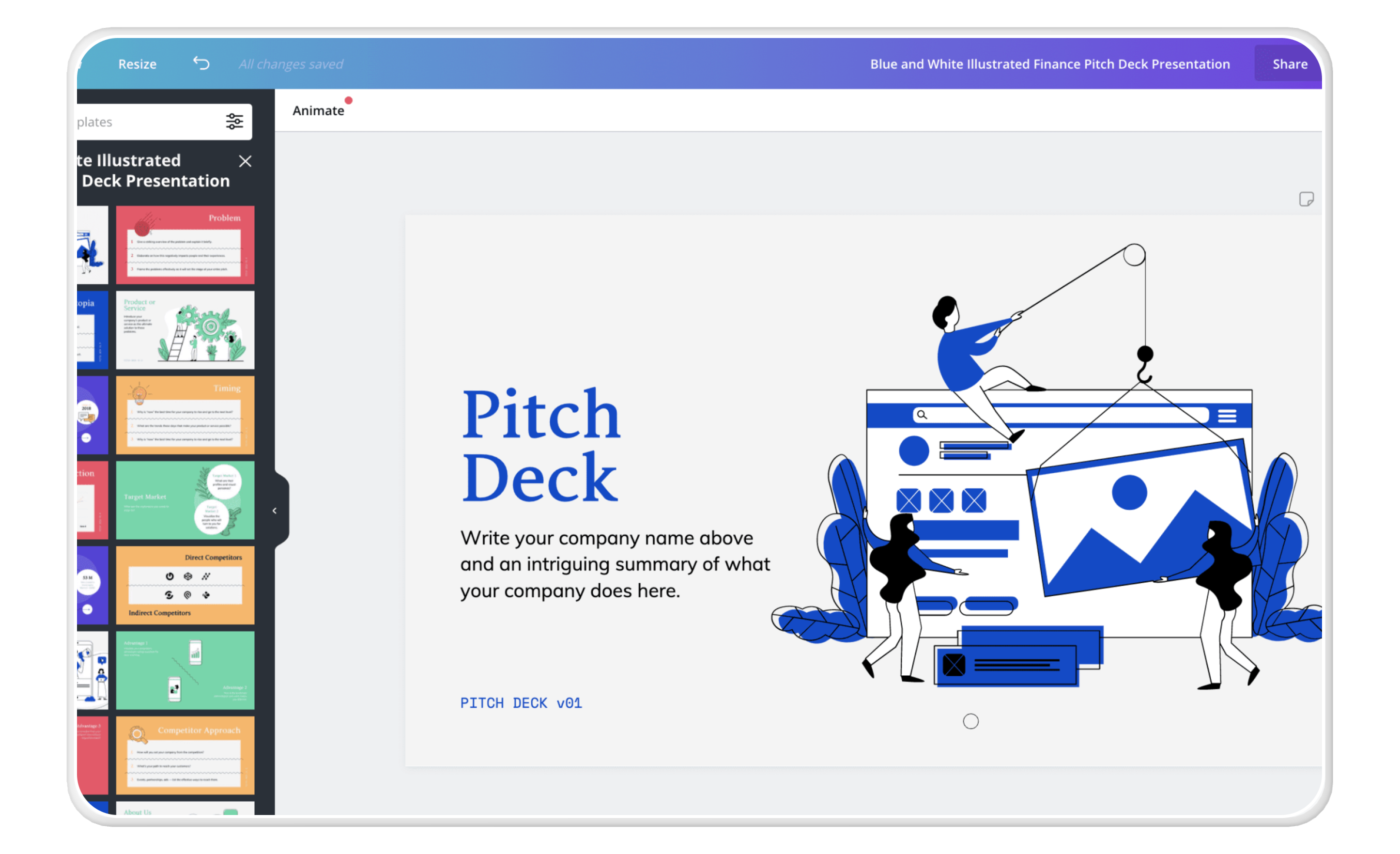
With templates for almost any design need and the ability to share brand colors, fonts, and images across your marketing team, there is almost nothing Canva can’t do. While the tool does offer a free plan, the Pro Plan provides access to even more features and functionality to help marketing teams design polished and professional graphics, presentations, and social media posts for every platform.
Canva is so easy to use that anyone in your marketing team can get started creating marketing materials right away.
Top features
- Easy-to-Use Design Templates: Access a wide range of customizable templates for B2B marketing materials such as brochures, infographics, and presentations.
- Brand Kit: Maintain brand consistency by storing and using your company’s logos, fonts, and colors across all marketing collateral.
- Collaborative Design Tools: Share designs with team members for feedback and collaboration, speeding up content creation for marketing campaigns.
- Social Media Integration: Design and directly publish visually appealing social media posts tailored to B2B audiences on platforms like LinkedIn.
- Presentation and Proposal Creation: Create polished presentations and proposals that appeal to B2B clients, without the need for advanced design skills.
Pricing
- Canva Free: Free forever
- Canva Pro: $120 USD / year
- Canva Teams: $100 USD per person / year
- Canva Enterprise: Contact sales
9. Primer: Best B2B marketing audience creation tool
G2 review: 4.5/5 (16 reviews)
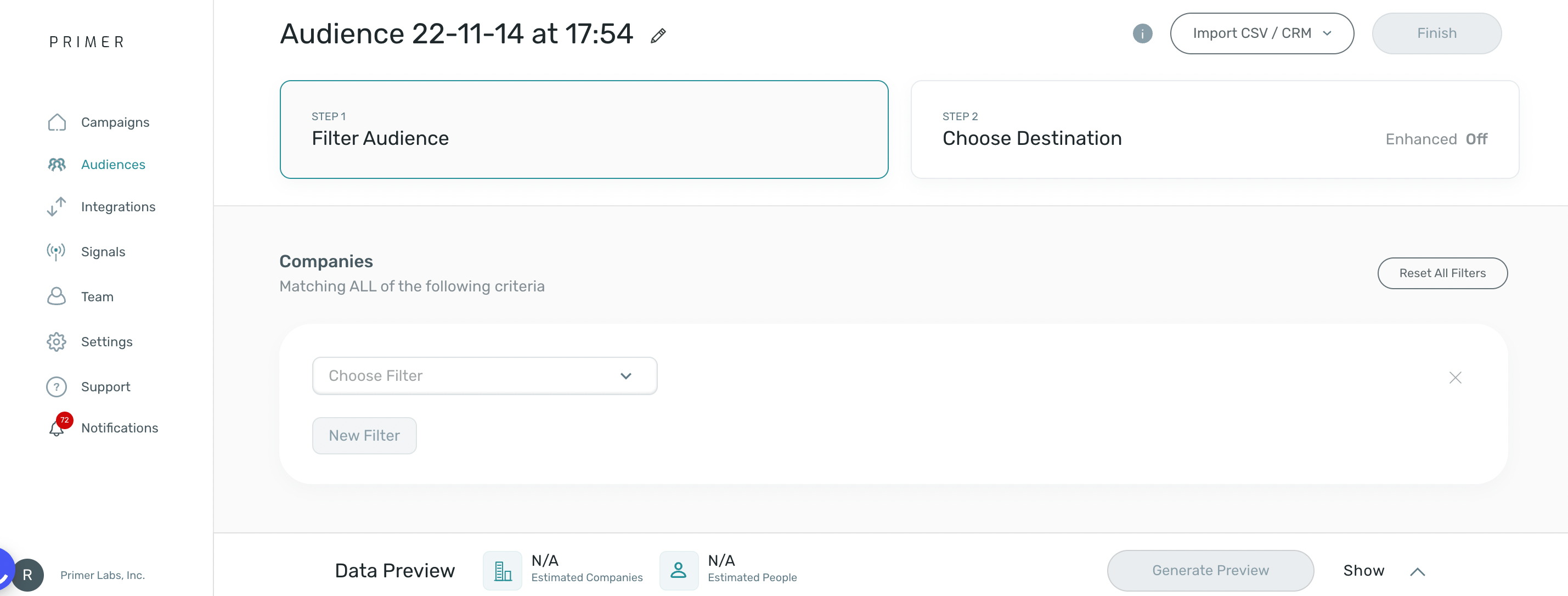
Primer claims to make account-based marketing easier and helps marketing teams create and segment audiences for targeted outreach. And with Primer, you can get really specific about who is in each of your audiences. According to their website, Primer is radically transparent about audience membership. They allow users to see the specific individuals going into audiences - on any channel. With high cross-channel match rates, the chance of your audiences being 1:1 goes up dramatically.
Although it’s designed for B2B marketers it allows for audience visibility even on B2C channels like Instagram, Youtube, and Facebook to expand your reach.
Top features
- Automated Lead Nurturing: Set up automated lead nurturing workflows to keep B2B prospects engaged over time without manual follow-up.
- Personalized Email Campaigns: Send personalized, data-driven email campaigns that are relevant to specific B2B segments or stages in the buyer journey.
- Multichannel Campaigns: Manage and coordinate B2B marketing campaigns across multiple channels, including email, social, and web.
- Behavioral Triggers: Use behavioral triggers to automate actions based on how B2B leads interact with your content or website, driving timely engagement.
- Marketing Analytics Dashboard: Get comprehensive insights into the performance of your B2B campaigns, tracking key metrics such as open rates, engagement, and conversions.
Price
- Primer Grow: $1,000 USD for 8 active audiences / month
- Primer Scale: $1,666 USD for 15 active audiences / month
10. Mutiny: Best website personalization platform
G2 review: 4.7/5 (22 reviews)
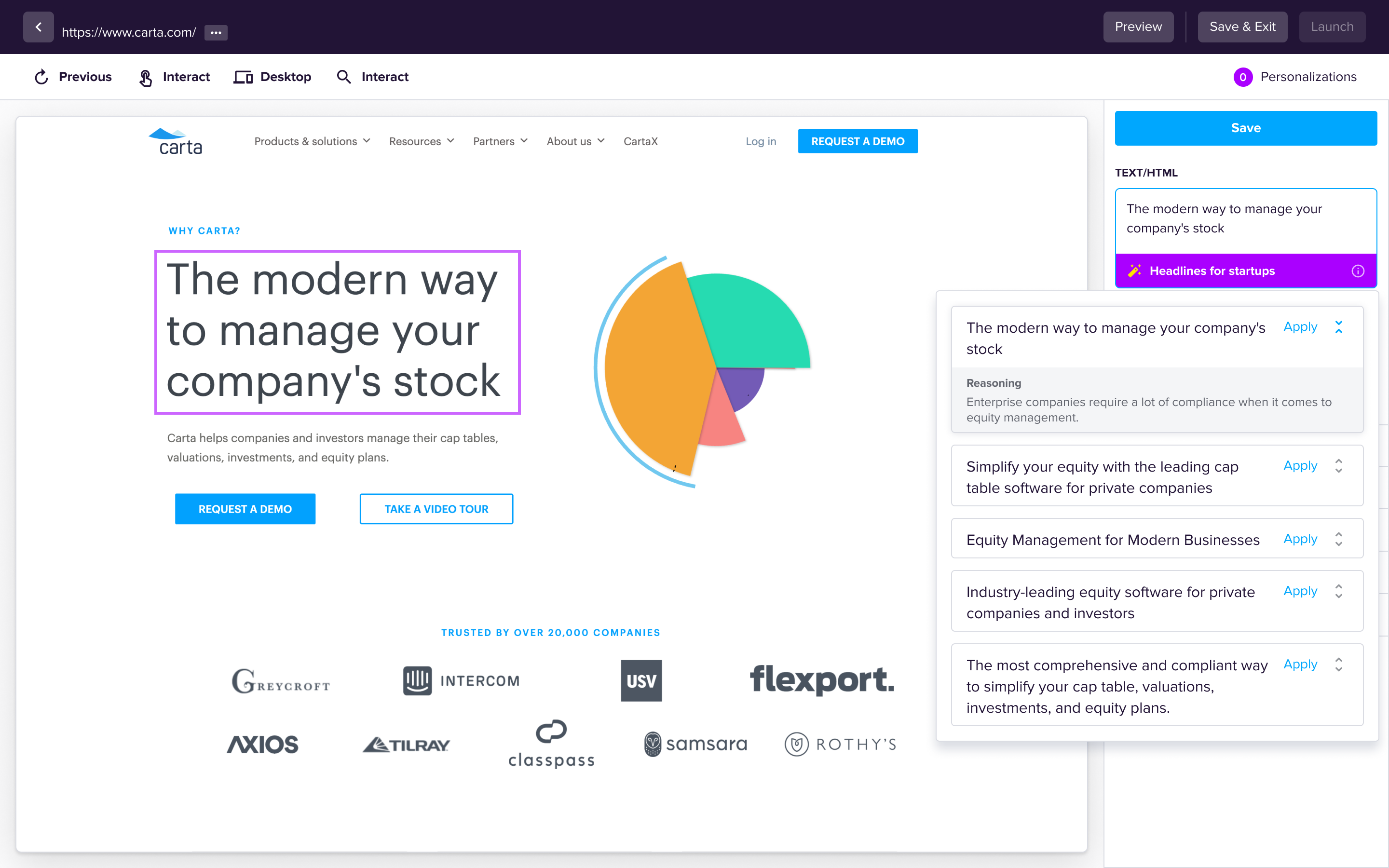
Mutiny is an AI-powered product that allows for personalization at scale. In the past, A/B testing was a time-consuming process and involved additional support from design and engineering to code additional pages. Now, any marketer can get started in minutes with Mutiny.
This B2B marketing tool allows marketers to customize and personalize pages on their website in just minutes, with a few clicks. If conversion optimization is on your list of goals this year, an investment in Mutiny might be a wise one.
Top features
- Website Personalization for B2B: Personalize website content for different B2B buyer personas, industries, and roles to boost relevance and engagement.
- Targeted Messaging: Automatically tailor messaging and calls-to-action based on company size, industry, or role to align with B2B visitors’ specific needs.
- Conversion Rate Optimization: A/B test personalized web content to improve conversion rates, guiding B2B visitors through the buyer’s journey more effectively.
- Account-Based Marketing (ABM) Support: Personalize the web experience for high-value accounts in your ABM strategy, increasing the chances of converting key prospects.
- Integrations with CRM and Marketing Tools: Seamlessly integrate with tools like Salesforce and HubSpot to enhance personalization efforts based on CRM data.
Pricing
Contact sales
11. Clearscope: Best SEO content optimization tool
G2 review: 4.9/5 (91 reviews)
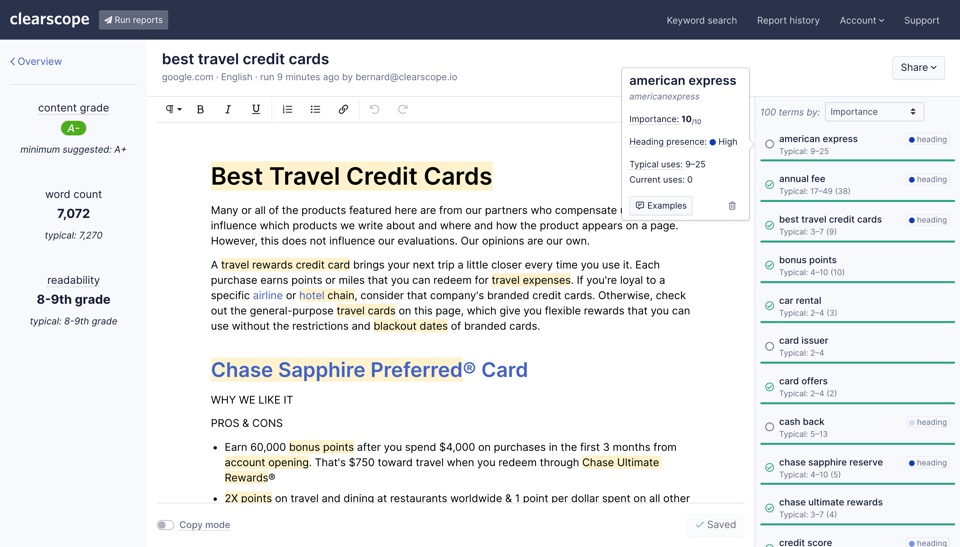
Keeping up with Google’s changing algorithms is no easy feat— it’s always a good idea to have an SEO content tool, such as Clearscope, in your corner. From recommending keywords to include in an article to helping writers structure their content to get the most bang for their buck, it’s a powerful tool that should be in every search marketer’s toolbox.
If you outsource some of your team’s content creation to freelancers, it’s easy to share Clearscope links with them and instruct them to create their assigned content to the Clearscope target score.
While we think Clearscope is great, we have noticed that some keyword insert recommendations can be a little over the top—such as recommending using an unimportant word 10 times on a page. As with all content creation tools, use it as an aide, and not the final word.
Top features
- SEO Content Optimization: Optimize B2B marketing content to rank higher on search engines by using Clearscope’s data-driven keyword and content recommendations.
- Content Grading System: Analyze and grade your content based on its relevance to target keywords, ensuring it meets B2B search intent.
- Competitor Content Analysis: Identify what content competitors are ranking for and refine your own content to outperform them in the B2B space.
- Topic Research: Discover trending topics and content gaps in your industry to create content that resonates with B2B buyers and boosts search rankings.
- Real-Time Content Feedback: Receive real-time feedback and suggestions while writing content to ensure it's optimized for search and audience engagement.
Pricing
- Essentials: $189 USD / month
- Business: $399 USD / month
- Enterprise: Custom pricing
12. Livestorm: Best webinar management tool
G2 review: 4.4/5 (1,578 reviews)
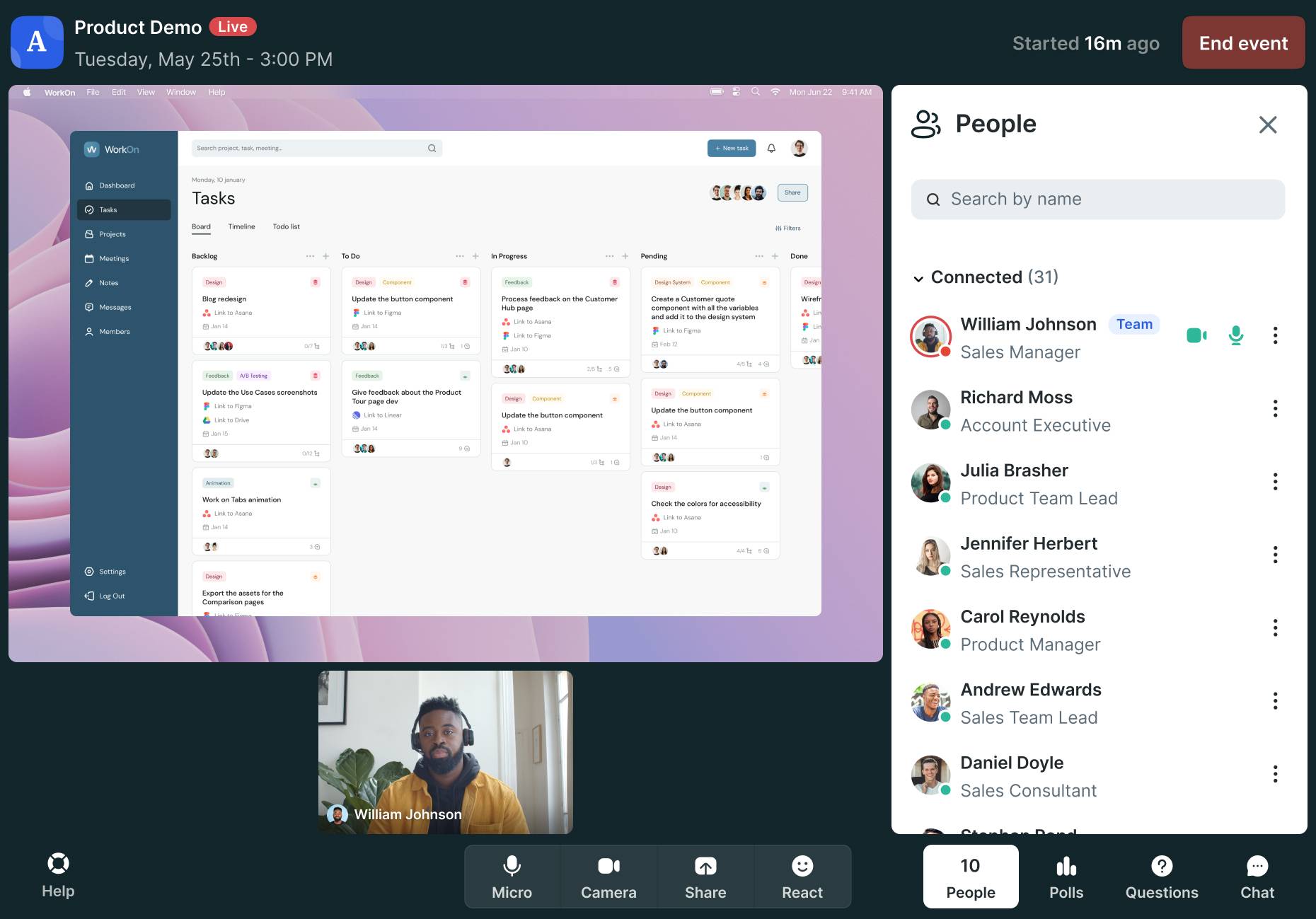
Livestorm bills itself as a simple meeting and webinar platform with built-in tools, to grow and collaborate. These engaging tools include virtual whiteboards, the ability to showcase up to 25 speakers, instant replays (hello bio breaks), the ability to add calls to action, and so much more.
You can create webinar sign-up pages that are optimized to convert, and the platform integrates with other B2B marketing tools like Hubspot, Marketo, and Pardot.
Host your product demos, continuing education, and even panel discussions on this platform and enjoy new and engaging ways of interacting with your audience, plus a robust suite of analytics tools to understand your impact and results.
Top features
- Webinar Hosting and Automation: Run live or automated webinars tailored to B2B audiences, helping generate leads, nurture prospects, and showcase your expertise.
- Audience Engagement Tools: Engage B2B prospects during webinars with live polls, Q&A sessions, and chat features, making the experience more interactive and personalized.
- Integrated Analytics: Track webinar performance with in-depth analytics, including attendee engagement, drop-off points, and follow-up opportunities.
- On-Demand Webinars: Offer on-demand webinars to B2B buyers who couldn’t attend live, extending the reach of your content and lead generation efforts.
- Seamless Integrations: Connect with CRM and marketing tools like HubSpot, Salesforce, and Marketo to streamline follow-up processes and nurture webinar leads.
Pricing
- Pro: $79 USD / month
- Business: Contact sales
- Enterprise: Contact sales
13. Klaviyo: Best B2B email marketing software

There’s no doubt that a powerful email marketing and automation platform is a crucial element of a B2B marketing tech stack. Well, Klaviyo is designed to help B2B companies deliver personalized, data-driven email and SMS marketing campaigns with comprehensive features that scale with your business.
But don’t just take our word for it. Katarina Brajković, Email Marketing Director at Digital Silk is our expert on the matter and recommended Klaviyo:
I love its segmentation and analytics. I love how it gives me the option to optimize emails for mobile. It can be integrated with everything. They also have amazing and very fast support.
Top features
- Advanced Segmentation: Target specific B2B audiences by segmenting based on behavior, demographics, purchase history, or interactions with your content. This ensures more personalized and relevant marketing.
- Marketing Automation Workflows: Build automated email and SMS workflows that nurture leads, onboard new customers, or re-engage cold prospects, streamlining your marketing efforts and saving time.
- Behavioral Tracking: Track and analyze how B2B prospects interact with your emails, website, and products to better understand their needs and optimize your campaigns based on real-time data.
- Seamless CRM and eCommerce Integrations: Easily connect Klaviyo with CRM platforms like HubSpot or Salesforce, as well as eCommerce systems, to sync data and create more impactful, personalized campaigns.
- Comprehensive Analytics and Reporting: Get detailed insights into campaign performance, including open rates, click-through rates, and ROI, allowing B2B marketers to make data-driven decisions and refine their strategies.
Pricing
Klaviyo’s pricing is based on how many active profiles you have. The below is based on 251-500 active profiles.
- Email: $20 USD / month
- Email and SMS: $35 USD / month
14. Design.com: Best brand-building tool
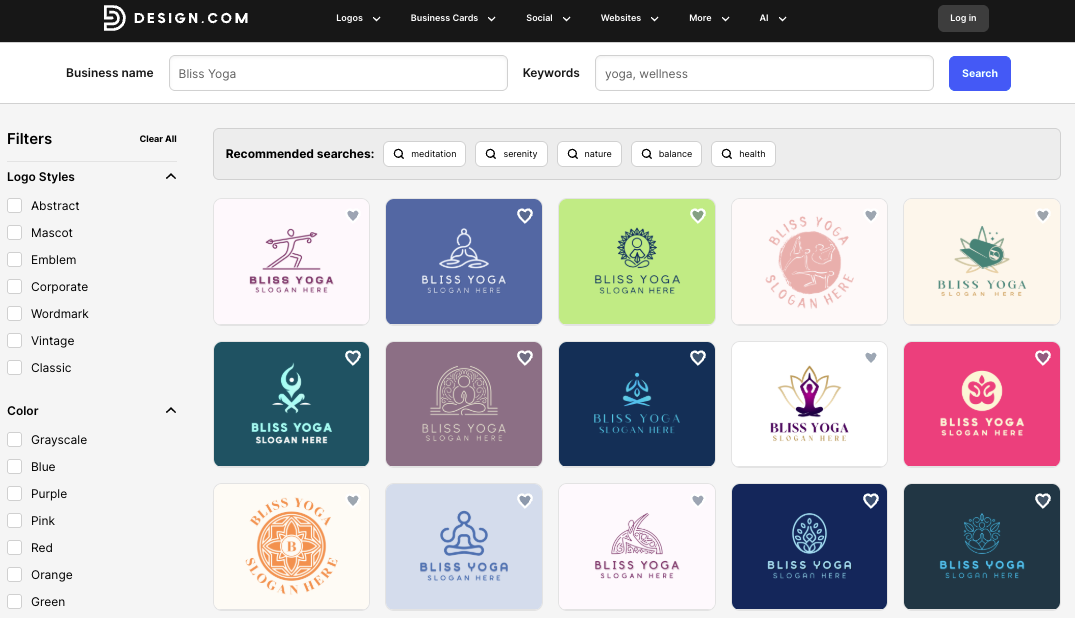
If you’re looking to create a cohesive and professional brand from the ground up, Design.com is a top-tier solution. This all-in-one branding platform helps businesses establish a strong identity by providing everything from a logo maker and domain names to social media templates and launch-ready websites powered by intuitive AI tools.
Design.com stands out by focusing squarely on branding. It’s ideal for startups, entrepreneurs, and growing businesses that need a whole brand system that looks and feels consistent across every touchpoint.
Getting started is simple: enter your business name, choose your style preferences, and within seconds, you'll have logo options ready to go. From there, you can create a complete brand identity: matching color palettes, fonts, icons, and templates for social media, websites, and more.
Unlike traditional design tools, Design.com streamlines the entire brand-building process. Whether launching a new business or rebranding an existing one, it gives you everything you need to look professional and polished from day one.
Top features
- AI-powered logo generator: Quickly create a professional AI logo design tailored to your business name and style preferences.
- Business name generator: Need a name first? Design.com helps you brainstorm with an AI-assisted business name generator.
- Branded business documents: Automatically generate essential materials for your brand, like business cards, invoices, posters, flyers, letterheads, and email signatures, to ensure consistent brand identity across all touchpoints.
- Domain name integration: Instantly check and secure a domain name that matches your new brand.
- Website and store builder: Launch a modern, branded website or e-commerce store without coding.
- Social media templates: Access a range of ready-to-use templates to keep your branding consistent across platforms.
- Easy customization: With an easy-to-use editor, you can tweak layouts, icons, fonts, and more to match your brand’s personality.
Pricing
- Freemium account for if you’re just getting started, and the best part? Your logo is yours to keep forever, even if you cancel.
- Premium plans: from $5 USD / month
Choosing the right B2B marketing platform for your business
So…which of these tools do you actually need? Let’s narrow it down with a few key questions based on Katarina Brajković’s considerations: “First question is always - will this be a good match for my clients/my needs? You don't offer Marketing cloud to an e-commerce brand. Second - Can I integrate it with my site, CRM, social channels? Third - analytics and segmentation possibilities - the more the merrier. Fourth: Pricing - is it worth it? Lastly - Ease of use. Nobody wants to spend 3 hours on something that can be done in 15 minutes.”
How big is your marketing team, and what marketing channels do you leverage?
When determining what tools you might purchase or add to your technology stack, start by thinking about how big your marketing team is and what channels you leverage (or want to leverage). You also want to consider whether your team is focused on outbound or inbound marketing strategies. For example, if your bread and butter is email or SMS marketing, a tool that helps with scheduling on Meta and TikTok might not be the best investment.
If your team plans to double down on video, email marketing tools or an email segmentation tool might not be the right move at this time.
And if your team does more traditional (offline marketing), like experiential events and trade shows, many digital marketing tools might not move the needle for you now.
Regarding team size, this is a consideration because even automation tools take manpower to set up and monitor. If you have a really small team, adding too many tools (or too many channels) might risk spreading your team too thin.
Are there any tasks your team is doing manually that you’d love to be able to automate?
Once you’ve thought about your team and the channels you’re leveraging (or wanting to leverage) most, think about the current team’s workload. Are there things that are being done manually that might be worth automating?
This could include reporting, scheduling social posts, rounding up links for content marketing like the company newsletter, or even lead generation. There are tons of marketing automation tools on the market, and you can choose which ones you might want to leverage based on your team’s needs.
What is currently in your martech stack, and where are the gaps?
One thing we talk a lot about on the sales tech stack side that heavily applies to marketing technologies is integrations. Choosing tools that work well together will help save your team time and money. Instead of combining data sources, having the sources flow into one report or dashboard means more time to act on the data instead of just working to get it compiled.
For example, having data from Google Analytics and your social listening tool all flowing into one data studio report automatically can save time and effort to set up a report every week or month. Allowing you more time to take action. There are various free marketing report templates you can use to streamline performance tracking.
So, when thinking about adding to your stack, think about what you have and what you might need. For example, having your customer relationship management system (CRM) integrated with your proposal generation software can save time and reduce duplicate entries. This is why Qwilr is designed to integrate with popular CRMs like Hubspot and Salesforce.
How much time and money do you have to invest in adding or upgrading tools?
Fancy social media management and account-based marketing tools can take time to learn, implement, and manage, so if your team is already stretched, this might not be the right use of your budget, even if you have the dollars.
Think about your team’s time as well. If you don’t have the time (and can’t bring in some support) to run the tools, they won’t serve you well. So, before making an investment, consider the implementation plan. Who will set up and manage a new tool, and how much time will they need in order to do it right and see the return on investment?
How do you measure the success of your marketing program, and what metrics are you measured on?
Finally, think about how you and your leadership team evaluate the success of your marketing team. Are you measuring lead generation volume? In that case, boosting your b2b lead generation tools might make a lot of sense.
In a small business or startup environment the metrics will be totally different than in an enterprise organization. In the former website traffic might be a critically important success metric, whereas in the latter it may not matter as much.
Building the Martech stack to fuel business growth in your organization
If this article has helped you discover or reconsider some tools that might help streamline your workflows or optimize your marketing operations, we’ve done our job of helping you build the martech stack that will fuel your business growth.
But, we felt that wasn’t enough and want to offer you the opportunity to see Qwilr in action. If you’re looking for a robust solution for creating marketing collateral like one sheets and proposals, we’re here for you. Sign up today for a product demo.
About the author

Marissa Taffer|Founder & President of M. Taffer Consulting
Marissa Taffer is the Founder & President of M. Taffer Consulting. She brings over 15 years of sales and marketing experience across various industries to a broad range of clients.
